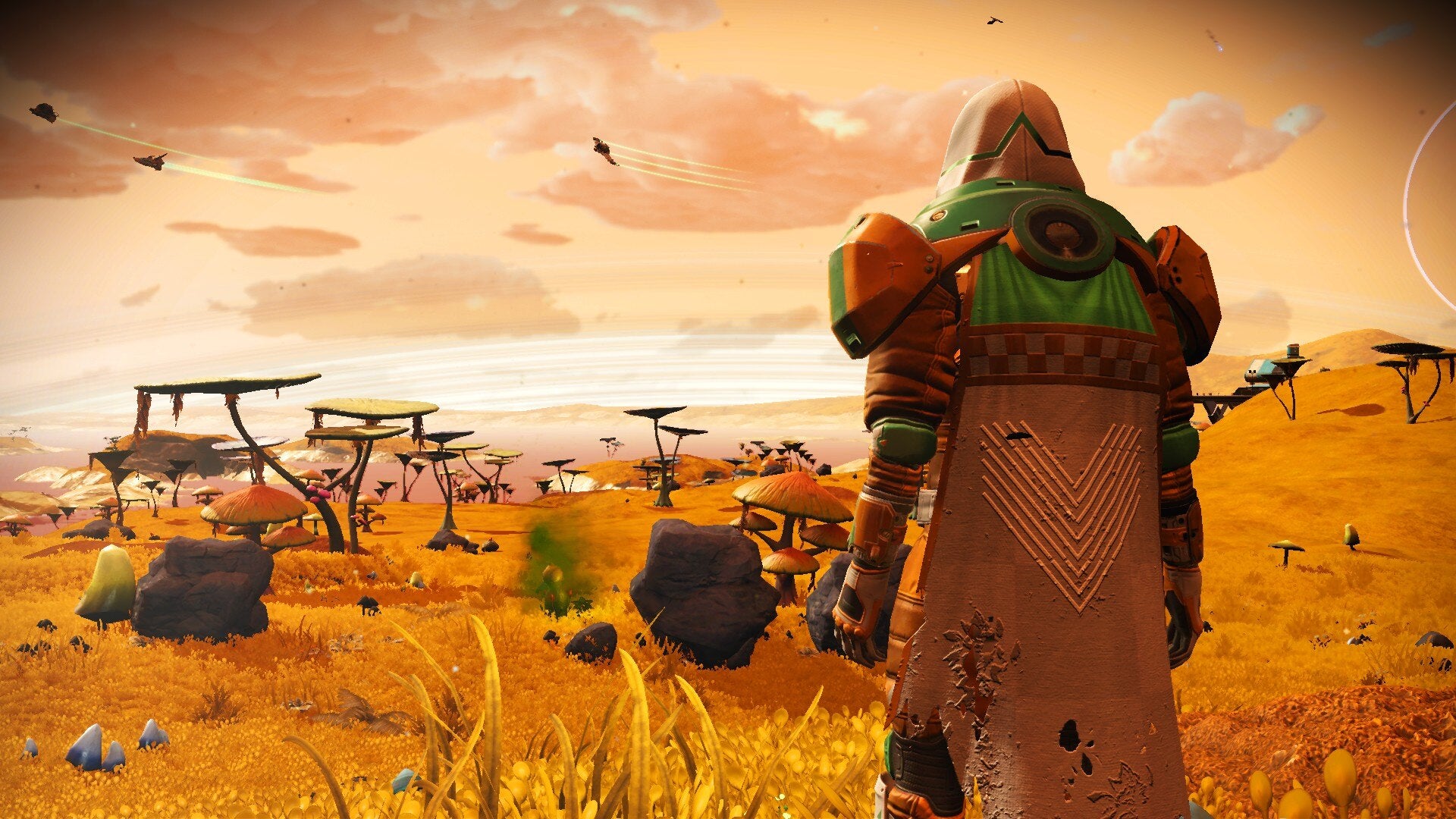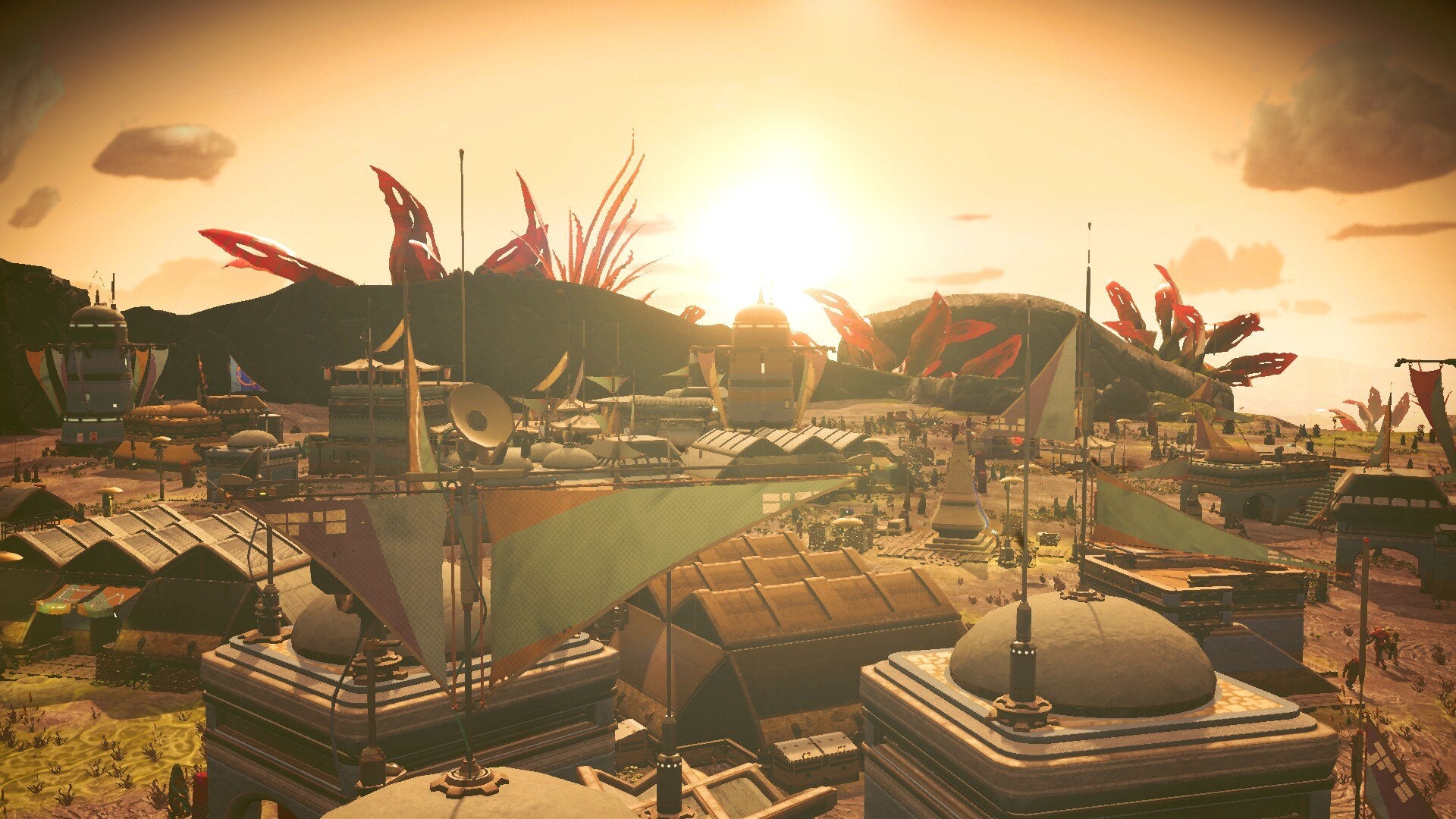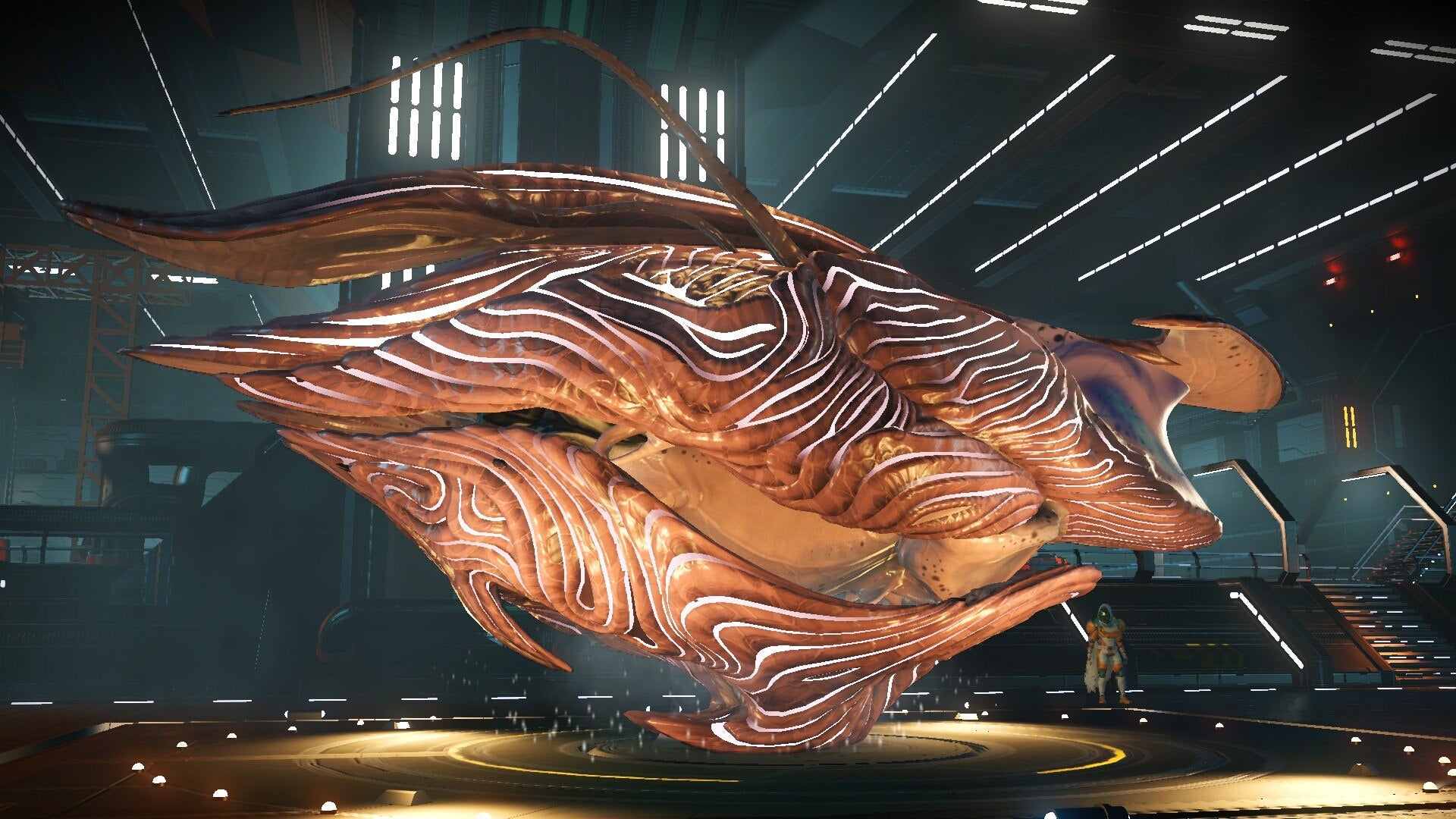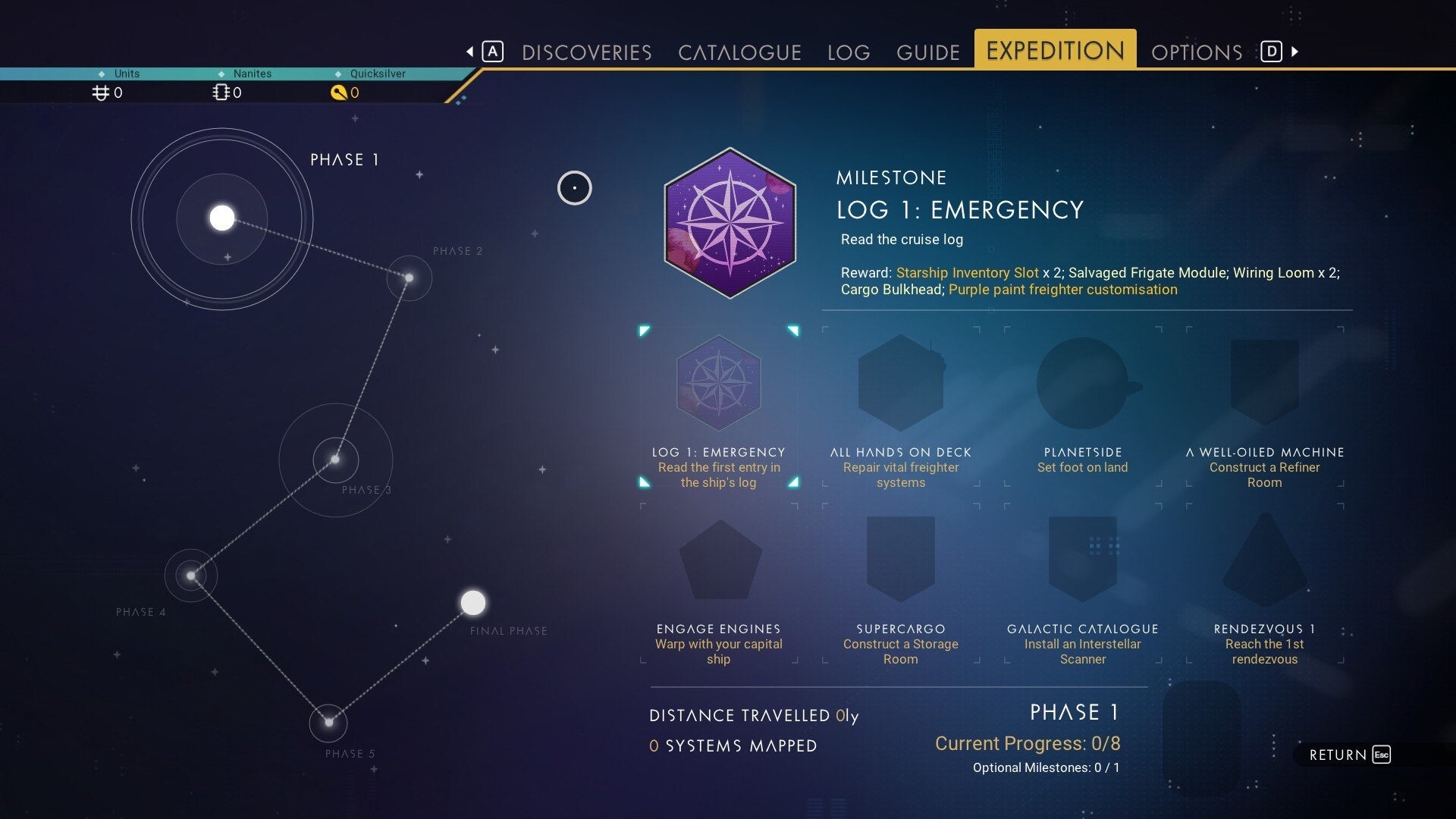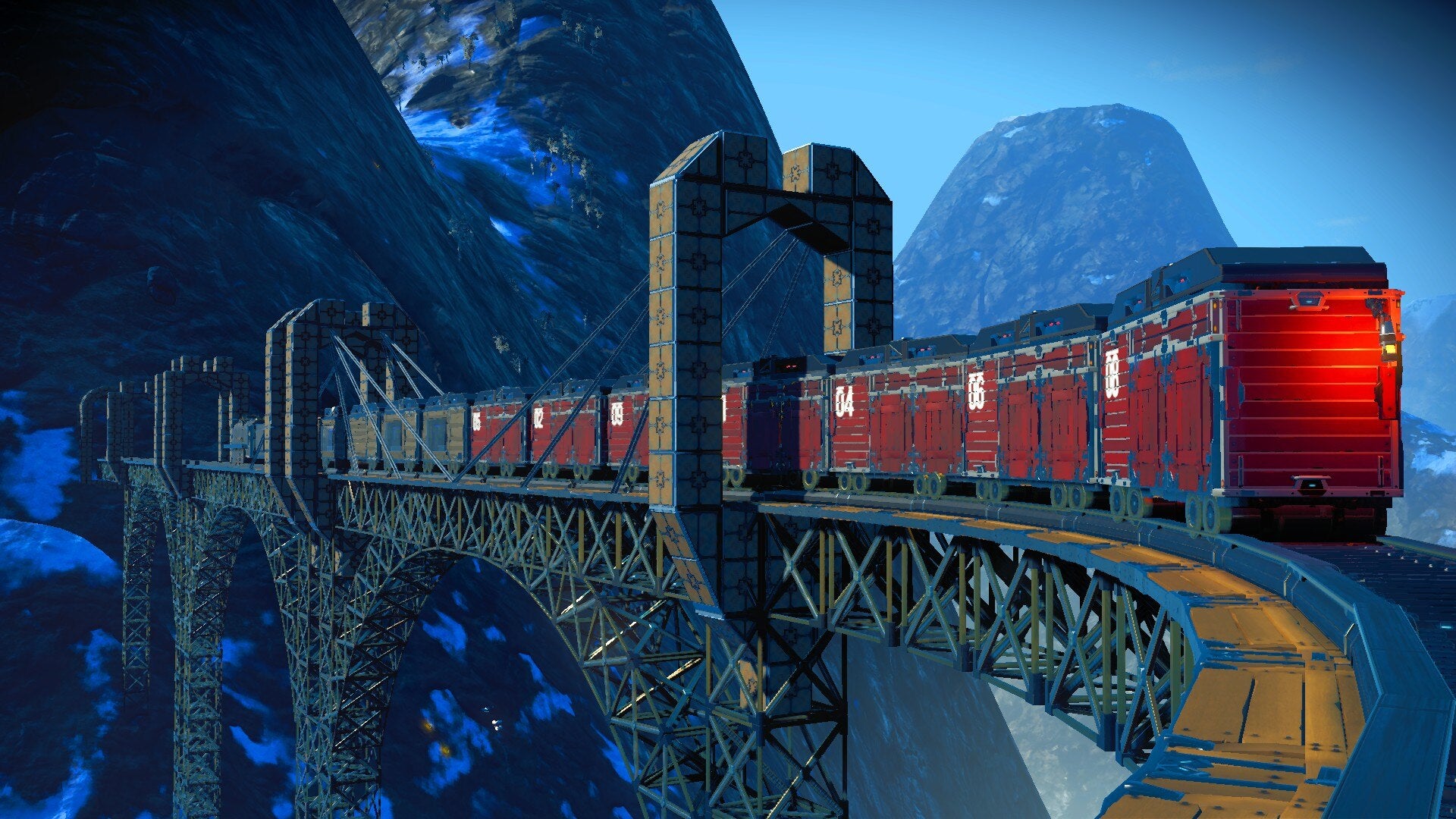And then it’s up, up, up, we go, past my newly renovated capital ship and its armada of frigates (the latest addition, a pulsating tentacled mass, wiggles encouragingly), past a space station recently commandeered by pirates, and then, with a little more room to manoeuvre, it’s time to do my worst. Within seconds the pirate threat is no more and peace, for now at least, is restored. Before I go home, though, I summon the imposing hulk of the inter-dimensional Space Anomaly and head in for a friendly rendezvous. Cake has been promised. No Man’s sky has, it’s fair to say, come a long, long way since its undoubtedly controversial launch in 2016. What was once a game of low-key, curiosity-driven exploration across a beautiful, often haunting, procedurally generated universe has morphed into something far bigger, far bolder, and, I think, after countless revisions and refinements, quite brilliant indeed. In the six years and 20 update since its arrival, No Man’s Sky has swelled to accommodate multiplayer, base building, dashboard bobbleheads, farming and cookery, customisable space freighters, land and water vehicles, massively expanded ocean gameplay, pilotable mechs, organic ships, space derelicts for spooky sci-fi adventuring, new flora and fauna, tameable pets and breeding, music tools, sand worms, robotic companions, space pirates, space whales, AI squadrons, settlements, new narrative adventures, curated Expeditions, and much, much more. It’s a near-overwhelming checklist of features at this point, but, for all its ever-swelling tangle of systems, No Man’s Sky still retains much of its original core; it remains an unquestionably idiosyncratic game of exploration, resource gathering, crafting, and inventory management, but, crucially, there’s now far less friction compared to launch. From much expanded inventory space, to auto harvesters massively reducing the resource grind, ample ways to accrue wealth, and land vehicles for more efficient traversal, the No Man’s Sky of today is one where you can spend far less time wrestling with the original’s sometimes cumbersome systems and far more time immersed in its vast, beautiful universe. Slowly, long-lingering bugs and other systemic oddities have been quashed. The confounding mess of competing, contradictory systems that dogged the game a few years back has largely been streamlined and resolved. Ageing, often shallow mechanics are finally being revised. This year alone has seen Hello Games take a hard look at space and ground combat, bringing sorely needed depth and variety to two of the game’s most pervasive systems. And as the studio continues to revisit its more anaemic systems, polishing up its creakier corners, it’s increasingly difficult to pinpoint No Man’s Sky’s genuine flaws. There’s always room for improvement of course (I’d still kill for starship strafing and the universe remains ripe for more curated narratives) but Hello Games continues to show a keen understanding of its sci-fi adventure’s strengths and weaknesses, and more importantly, a willingness to refine and evolve. Perhaps No Man’s Sky’s biggest transformation has been its conceptual shift from a game of relentless space tourism to something more like a deep-space life sim on an intergalactic scale. That shift began surprisingly early on, starting with No Man’s Sky’s very first post-launch update in November 2016. This, the Foundation Update, with its emphasis on base-building, slammed the breaks on a game previously built around ceaseless forward momentum. Where before, No Man’s Sky’s felt decidedly aloof - procedural planets and galaxies were little more than fleeting, almost immediately forgotten sights along an endless journey - the Foundation Update allowed players to form a more intimate, emotional connection with the universe as they finally paused to lay down roots and call a favourite corner home. Since then, in keeping with its newfound reinvention as a leisurely intergalactic life sim (albeit one still driven by exploration and personal accumulation), No Man’s Sky has been less concerned with the ‘Where next?’ and more focused on the ‘What now?’. ‘Who do you want to be today?’, it asks each time you log on. A pirate, perhaps, or a property magnate, a trader, an animal breeder, the governor of your own slowly expanding outpost, the choice is yours. You could follow in the footsteps of Ellen Ripley, embarking on a procedural dungeon-crawl across gloomy, alien-infested space stations to secure exotic loot; you could scour the galaxy to amass your own fearsome armada, sending your frigates out on lucrative real-time missions while you busy yourself elsewhere; you can turn to a life of smuggling, stealing illegal cargo from scoundrels then selling for massive gains in legit systems; or if you’re more of a Indiana Jones than a Han Solo, you can dig for fossils and other long-forgotten treasures. Or you can bake cakes; build exotic machinery to aid your planetary exploration; grow yourself a living ship from an egg; breed pets into ever-more extreme variants; explore with friends; build with friends; embark on procedural missions with friends, and on it goes. None of these systems are particularly deep, admittedly. Even after 20 updates and countless revisions, No Man’s Sky remains more interested in breadth than depth, focusing on delivering an accessible, arcade-y take on the ordinarily stodgy space genre. But I’d argue they’re as deep as they need to be, particularly when its breadth is as staggering as it is, even among its vastly more established genre peers. The scale of No Man’s Sky wouldn’t be possible, of course, if it wasn’t for Hello Games’ continuing appetite for expansion and evolution, which, in turn, has led to perhaps its most fascinating transformation into something remarkably close to a live-service game. Over the years, No Man’s Sky has transitioned from sporadic early updates to a far more regular release tempo, bringing sizable updates, smaller updates, and new limited-time events approximately every three or four months. It’s a model that can seem inescapable these days, of course, as publishers tie themselves in knots over engagement metrics and rolling revenue gains, but for No Man’s Sky it feels like a natural fit, turning what could have been a depressingly static procedural universe into something inviting, exciting, and wonderfully alive - and all without a microtransaction or paid expansion in sight. But that isn’t quite the full picture; the real secret to No Man’s Sky’s enduring success, I think, is that six years on it remains ceaselessly, delightfully unpredictable. In a world where even the best live-service games manage to sap all the excitement out of themselves with endless pre-update reveals - where every minor map change and addition is dissected in exhaustive detail ahead of each new release - there’s something enormously refreshing about Hello Games’ continuing coyness between updates, and it helps imbue No Man’s Sky’s universe with an ongoing sense of mystery, wonder, and surprise. Each new update brings a frequently astonishing amount of unexpected treats, mixing left-field surprises with much-requested community features, usability updates and, with increasing regularity, thoughtful system reworks that unequivocally make for a better game. And perhaps the most re-invigorating of these came last March in the form of Expeditions, an ongoing series of specially curated, objective-driven, limited-time experiences that condense No Man’s Sky’s labyrinthine systems down into more clearly defined 5-10 hour adventures. To date, there’ve been eight Expeditions, each finding intriguing, and increasingly ambitious new ways to spin No Man’s Sky’s core components. Expedition 4: Emergence, for example, went big on narrative, tasking players with uncovering the secrets of a sandworm-worshipping death cult, while Expedition 7: Leviathan went all-in on delivering a rogue-like adventure (albeit perhaps not entirely successfully) that became gradually easier as the community worked together to complete specific goals. The joy of all this is that Expeditions take No Man’s Sky’s biggest, most intimidating decision - What should I do next? - out of the equation. It’s a wonderful change of pace, zipping around the universe in a more contained, constrained way, particularly as Hello Games often uses Expeditions to draw attention toward systems that have become a little lost among years of revisions and updates. It’s not an exaggeration to say that, even as a day-one player, I’ve learned (and re-learned) an invaluable amount through Expeditions, helping make for a richer, more rewarding time back in the sandbox. And as a bonus, the unlockables earned - all of which can be transferred over to your main save - are a constant delight, ranging from personal pet sandworms and mission-ready space whales to Mass Effect’s Normandy SR1. Six years on, and in contrast to its rather tentative early post-launch years, Hello Games’ incredible passion for No Man’s Sky’s development is unmistakable, and perhaps more evident than ever. It remains a studio of few words after criticisms of misleading pre-launch hype, but the continuing scale and ambition of each new update speaks for itself. Hello Games’ clear enthusiasm for No Man’s Sky is infectious, and, vitally, is reflected in the game’s enormously energised, welcoming, and generous fanbase. It’s a fanbase that - mirroring Hello Games’ own trajectory - has rebuilt itself from a difficult launch to become one of the most relentlessly upbeat and helpful communities I’ve ever encountered in an online game. Players are all too happy to offer advice, gift rare commodities, show off their incredible builds, and post galactic coordinates so others can track down particularly striking ships or planetary discoveries. And even when things don’t go quite right - there are currently minor frustrations around the recent removal of freighter ramps, for instance - the community remains politely pragmatic, favouring humorously pointed memes over furious bluster. And, inevitably, all that positivity manifests in-game. For all the existential angst and brooding nihilism of No Man’s Sky’s narrative, Hello Games’ ever-expanding universe is simply a lovely, uncommonly welcoming place to be. And that may be its greatest achievement. No Man’s Sky will never be for everyone - its weird mix of cosmic wonder and philosophical melancholy, not to mention its decidedly idiosyncratic core, puts pay to that - but it’s somehow transcended the bitter acrimony of launch to become an object of genuine love and affection for hundreds of thousands of players. And that communal joy is at the heart of it all, really, seeping through even during the most solitary moments beneath the endless stars. That there’s so much to see and so much to do in 2022 is an astonishing achievement, that it retains a sense of magic and wonder even more so. Playing No Man’s Sky today always feels a little like coming home, and long may it continue to grow. This piece is part of our State of the Game series, where we check in on some of the biggest service games running to see how they’re getting on. You can find plenty more pieces like it in our State of the Game hub.
